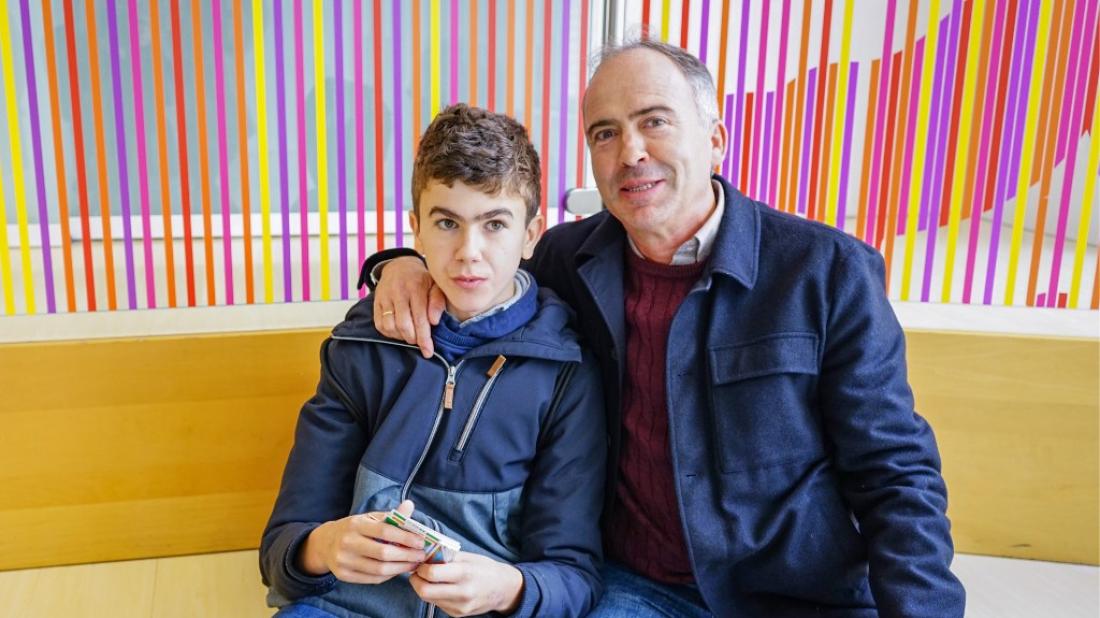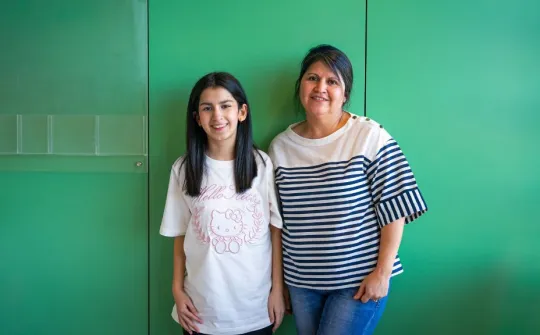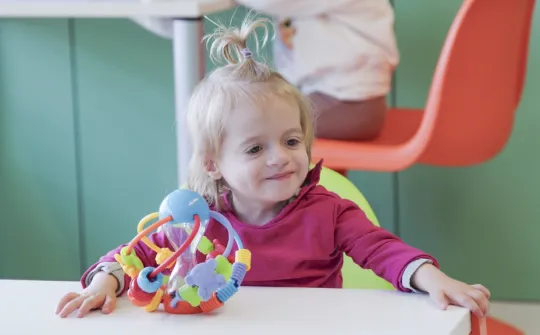
The parents of a teenager with SATB2-associated syndrome explain how finally getting a diagnosis allowed them to find out the prognosis of this rare disease, get in touch with researchers and meet other affected families.
Fernando and Teresa had to wait six years before they could finally put a name to the disease affecting their son, who, at 15 years old, cannot talk, has a behavioural disorder, and an intellectual and cognitive delay, among other limitations.
They knew that ‘there was something about Jaime’ from the day he was born, when the pediatrician examining him told them he had a cleft palate. But at no point did they think that the boy would have an ultra rare disease. ‘A cleft palate is a relatively common malformation that is usually treated successfully. At 11 months old, they operated and everything seemed to have been solved,’ recounts Fernando.
Unfortunately, that was not the case. When Jaime turned two, they noticed that he had not started developing his language skills and his movements were slower in comparison to his peers. ‘For example, he started walking at 20 months old. Pediatricians didn't give it much thought. They said that he simply had his own pace. But we knew that something was wrong, and we started actively looking into things in more detail,’ recalls the mother.
And so began their pilgrimage to various specialists. First in the Canary Islands, where the family is from. Then, Madrid. It was there, in May 2014, that the family scheduled a trio exome sequencing test, a study that analyses a huge volume of genetic material to find abnormalities that could be the cause of a disease. ‘Jaime had already undergone two arrays, but they didn't give us a definite result. Exome sequencing, which was a pioneering technique at the time, and had just started being done in Spain, allowed doctors to identify the genetic mutation causing Jaime's phenotype,’ explains the father.
The study revealed that the boy had a de novo genetic mutation (non-inherited), which had manifested spontaneously in the SATB2 gene. They had a diagnosis. ‘It was a huge step forward. Having a diagnosis opened many doors for us. We weren't alone anymore. We learned that, at present, Jaime's genetic mutation can't be treated with medication, but we could start looking for specialists who research or know something about the disease. We could also find other families with children in the same situation. We used social media to get in touch with the very few other cases at the time, all of them outside of Spain.’
More than 40% of children with SATB2 in Spain are treated at the SJD Barcelona Children's Hospital
Fernando and Teresa took to the internet to find as much information about SATB2-associated syndrome as they could, better known as Glass syndrome at the time. They managed to find and get in touch with a Genetics Researcher in Arkansas (United States) who had started studying the disease. Thanks to him, they were put in contact with another Spanish family whose child had the same syndrome.
Then, in 2016, they contacted Mercè Bolasell, the Case Manager at the SJD Barcelona Children’s Hospital. ‘We took the initiative. We saw that this hospital was very involved in rare diseases and that they had created a dedicated institute. That’s why we decided to write to them. They responded straight away, asking for information about Jaime's case and guiding us on what we had to do to get an appointment at the hospital's Genetics Department. It was us who asked doctors and the Canary Island Health Service to refer us here. Although Madrid would have been better from a logistical and family point of view, our main concern was Jaime's wellbeing. We didn't hesitate for one second,’ explains Teresa.
In March 2017, once all of the transfer and referral processes had been completed, Jaime and his parents travelled to Barcelona for an appointment with doctors Mercedes Serrano and Antonio Martínez, specialists in Neurology and Clinical Genetics at the SJD Barcelona Children's Hospital. Jaime was one of the first patients with this disease to be treated at SJD. ‘In three days, he was seen by six specialists. We felt so well looked after that we spread the word to the other families we had gotten to know over the years,’ explains Fernando.
At present, the hospital attends to 14 patients with SATB2-associated syndrome, with a further two having been referred to adult healthcare facilities once they were old enough. They make up more than 40% of the 35 confirmed cases of the syndrome in Spain.
At present, the SJD Barcelona Children's Hospital attends to 14 patients with SATB2-associated syndrome.
SATB2-associated syndrome one-day care to help affected families meet each other
Currently, many of these families meet one another in the waiting room at the SJD Barcelona Children's Hospital when attending medical appointments. Seven years ago, the hospital launched various initiatives to reduce the number of journeys patients had to make, as oftentimes, like with Jaime's family, they live outside of Catalonia. One of these initiatives involved grouping as many appointments as possible together into the one day.
Another initiative was the one-day care programme for those syndromes for which, for one reason or another, it was unnecessary or not possible to bring together specialists from several disciplines. In such cases, patients with a specific syndrome are all scheduled for the same day at the Clinical Genetics and/or Neurogenetics Department to help families meet and get to know one another.
‘Meeting families of other patients is fundamental,’ explains Fernando. ‘When Jaime was diagnosed with SATB2-associated syndrome and we started to look into it and get in touch with other families, especially in the United States, we were relieved to learn about one patient who was 32 years old. Until that point, we had lived with the uncertainty of how our son's disease could progress.’
Jaime's father continues sharing his experience, noting that ‘thanks to new technology, we can keep in touch with families both in Spain and around the world. But the appointments at the SJD Barcelona Children's Hospital let us meet in person, and that's also hugely important. Not just that, but when there were fewer affected families in Spain, the hospital guided us in setting up the Asociación Española del Síndrome Asociado al SATB2 [Spanish Association of SATB2-associated Syndrome].’For parents, however, the most important aspect is that the medical team at SJD acts as a bridge or link to other research teams around the world. ‘They see a huge number of affected patients in Spain, and can share their data with other researchers investigating the disease in the United States, United Kingdom and The Netherlands, among other countries, to make significant progress. For us, that is vital,’ concludes Fernando.



